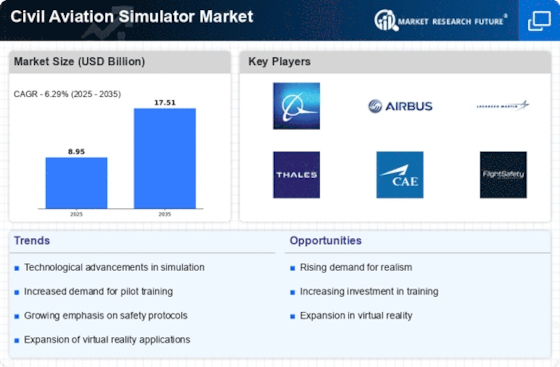Focus on Pilot Safety
Pilot safety remains a paramount concern within the Civil Aviation Simulator Market. The aviation sector continuously seeks to enhance safety protocols, and flight simulators play a crucial role in this endeavor. By providing realistic training scenarios, simulators enable pilots to practice emergency procedures and complex flight maneuvers in a controlled environment. This focus on safety is reflected in the increasing investment in simulator technology by airlines and training organizations. Data indicates that the aviation industry is projected to allocate a significant portion of its training budgets to simulator-based training, with expectations of a 7% increase in spending over the next few years. This trend highlights the critical role of simulators in fostering a culture of safety and preparedness among pilots.
Regulatory Compliance
Regulatory compliance is a critical driver in the Civil Aviation Simulator Market. As aviation authorities worldwide enforce stricter training requirements for pilots, the demand for high-fidelity simulators increases. These simulators must meet specific standards set by regulatory bodies, ensuring that pilots receive adequate training before operating commercial aircraft. The need for compliance with regulations such as those from the Federal Aviation Administration (FAA) and the European Union Aviation Safety Agency (EASA) propels the market forward. Training organizations are investing in advanced simulators to ensure they meet these regulatory standards, which is likely to result in a market growth rate of approximately 6% annually. This trend underscores the importance of simulators in maintaining safety and operational efficiency in the aviation sector.
Technological Advancements
The Civil Aviation Simulator Market is experiencing a surge in demand due to rapid technological advancements. Innovations in virtual reality, artificial intelligence, and machine learning are enhancing the realism and effectiveness of flight simulators. These technologies allow for more immersive training experiences, which are crucial for pilot proficiency and safety. As airlines and training institutions seek to improve their training methodologies, the integration of these advanced technologies becomes paramount. The market is projected to grow significantly, with estimates suggesting a compound annual growth rate of over 5% in the coming years. This growth is driven by the need for more sophisticated training tools that can adapt to the evolving aviation landscape.
Cost Efficiency in Training
Cost efficiency is a pivotal factor influencing the Civil Aviation Simulator Market. As airlines and training institutions strive to reduce operational costs, simulators offer a viable solution by providing a cost-effective training environment. Simulators allow for repeated practice of various flight scenarios without the associated costs of actual flight training. This aspect is particularly appealing in an industry where training expenses can be substantial. Market analysis suggests that the use of simulators can reduce training costs by up to 30%, making them an attractive investment for airlines. As organizations seek to optimize their training budgets while maintaining high safety standards, the demand for advanced simulators is expected to rise, contributing to the overall growth of the market.
Increased Air Travel Demand
The Civil Aviation Simulator Market is significantly influenced by the rising demand for air travel. As more individuals and businesses opt for air transportation, airlines are compelled to expand their fleets and enhance pilot training programs. This increase in air travel necessitates a corresponding rise in the number of trained pilots, thereby driving the demand for flight simulators. Market data indicates that the number of commercial pilots is expected to grow by over 10% in the next decade, creating a substantial need for effective training solutions. Consequently, flight training organizations are investing heavily in simulators to ensure that they can meet the growing demand for qualified pilots, which is likely to bolster the market further.


















Leave a Comment